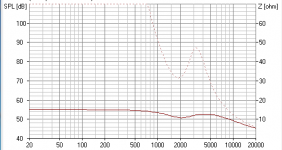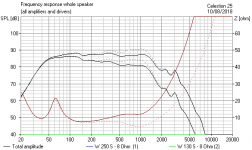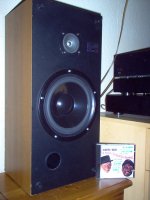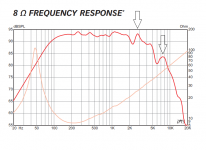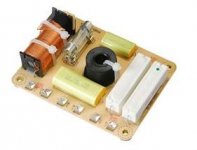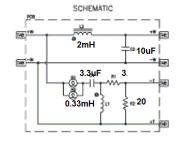I bought a pair of Klipsch KG4.5 speakers in good shape. I kind of like them (my first horn speakers), but they have a harshness in the treble that I'm trying to tame.
So far I've applied a layer of duct seal (a la Planet10) to both the tweeter horn and the woofer frame, which has helped gain clarity and smoothness. But the tweeter still has a little sizzle to the top end that bothers me.
A lot of people have said to replace the crossover capacitors, but they look like reasonable quality metallized Mylar film. How bad can those possibly be?
Here's the crossover schematic:
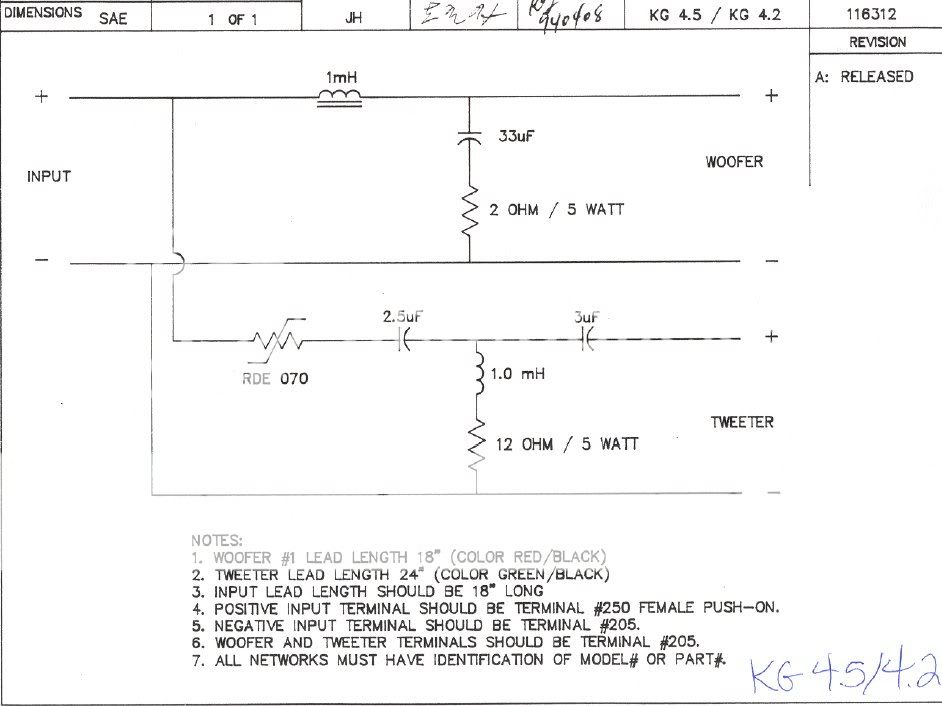
I was experimenting with putting a resistor across the + and - terminals of the tweeter. When I put a 50 ohm 10W wirewound there, the highs definitely get smoother and less brash, but maybe too 'dead.' When I put 100 ohm 10W it smooths the highs just a little tiny bit.
Here's what I've done to it:
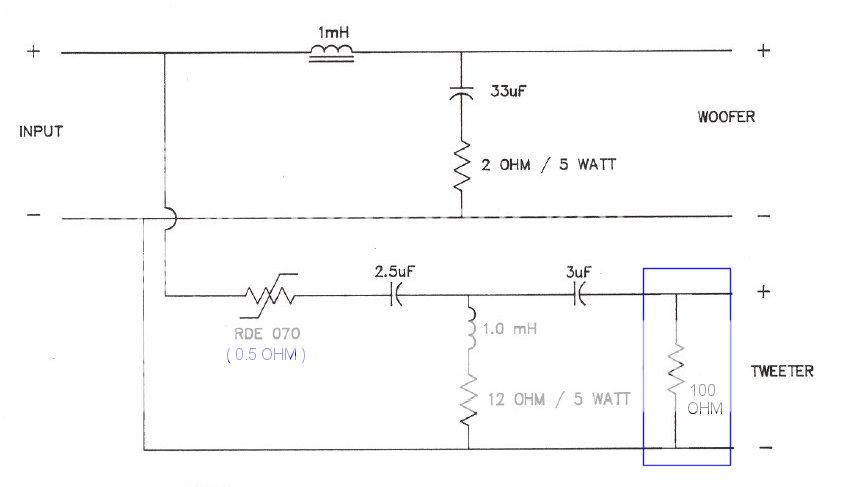
Right now I'm listening with the 100 ohm there, and I think I want to try something like 82 ohms (split the difference between 50 and 100 ohms).
My question is -- Am I doing something incredibly stupid and wrong? I mean in general terms. I don't have the actual driver specs, so I understand that the crossover can't be properly analyzed from just the schematic. But in general terms, is putting a resistor across the tweeter likely to cause a problem?
Am I just attenuating the tweeter output by setting up a simple voltage divider between the series resettable fuse (that "polyswitch" thingie, which has 0.5 ohm internal resistance) and the parallel resistor?
Thanks...
So far I've applied a layer of duct seal (a la Planet10) to both the tweeter horn and the woofer frame, which has helped gain clarity and smoothness. But the tweeter still has a little sizzle to the top end that bothers me.
A lot of people have said to replace the crossover capacitors, but they look like reasonable quality metallized Mylar film. How bad can those possibly be?
Here's the crossover schematic:

I was experimenting with putting a resistor across the + and - terminals of the tweeter. When I put a 50 ohm 10W wirewound there, the highs definitely get smoother and less brash, but maybe too 'dead.' When I put 100 ohm 10W it smooths the highs just a little tiny bit.
Here's what I've done to it:

Right now I'm listening with the 100 ohm there, and I think I want to try something like 82 ohms (split the difference between 50 and 100 ohms).
My question is -- Am I doing something incredibly stupid and wrong? I mean in general terms. I don't have the actual driver specs, so I understand that the crossover can't be properly analyzed from just the schematic. But in general terms, is putting a resistor across the tweeter likely to cause a problem?
Am I just attenuating the tweeter output by setting up a simple voltage divider between the series resettable fuse (that "polyswitch" thingie, which has 0.5 ohm internal resistance) and the parallel resistor?
Thanks...
Have you tried the Klipsch forums?
Yes, but no answer from there yet. But this isn't really Klipsch-specific... Seems like a general crossover question.
BTW, I found this in the Multi-Way stickies...
Flattening the Tweeter's Impedance
That shows something like what I was thinking. But it also suggests that putting the resistor there changes the impedance of the tweeter, so changes the way the tweeter crossover components act on the tweeter (changes the -3dB point?).
-=|=-
It will likely make small reductions in output where there are currently impedance peaks, and also increase damping somewhat of the crossover. There will be some attenuation of the whole tweeter but it will most likely be insignificant. So...greatest effect nearer the crossover. No, no damage likely.
I also wonder whether someone else has had this exact problem and found a good fix?
I also wonder whether someone else has had this exact problem and found a good fix?
Stumbled upon this, could help but add my two cents. Apologies for the ancient thread bump.
Exact same experience with my Klipsch KG 5.5's. Stupidly wonderful outcome for a few dollars and some time.
Inspired by AllanB....
Exact same experience with my Klipsch KG 5.5's. Stupidly wonderful outcome for a few dollars and some time.
Inspired by AllanB....
An interesting thread. It's a weakness of what is effectively a single cap filter that it doesn't damp the tweeter voicecoil and that pesky ca. 1kHz resonance known as the Fs at low frequencies.
Various tweaks can help. Ferrofluid, Zobels around 7.5R plus 0.68uF for 6 ohm drivers. A shunt resistor around 15R across the tweeter. An attenuator does much the same as a simple resistor, of course. But reduces level.
TBH, that isn't the greatest filter in terms of adequacy.
When you then remove these tweaks, initially it all sounds brighter. But then you pickup a hard sound again. All is compromise!
Various tweaks can help. Ferrofluid, Zobels around 7.5R plus 0.68uF for 6 ohm drivers. A shunt resistor around 15R across the tweeter. An attenuator does much the same as a simple resistor, of course. But reduces level.
TBH, that isn't the greatest filter in terms of adequacy.
When you then remove these tweaks, initially it all sounds brighter. But then you pickup a hard sound again. All is compromise!
It WAS a good story! 
Trial and error and use of listening. Listening is what it's all about.
If you want the nearest I can get to a scientific basis, here's the effect of a 15R shunt on what the 6 ohm tweeter sees in terms of damping of the voicecoil back down the filter. The shunt will reduce impedance a little, but not affect the slopes much. Dotted is without the shunt.
Trial and error and use of listening. Listening is what it's all about.
If you want the nearest I can get to a scientific basis, here's the effect of a 15R shunt on what the 6 ohm tweeter sees in terms of damping of the voicecoil back down the filter. The shunt will reduce impedance a little, but not affect the slopes much. Dotted is without the shunt.
Attachments
I wish AllenB's update post had been available to me back when I had those speakers. I sold them off, long ago.
I followed a lot of suggestions and tried a lot of things trying to get these speakers to work for me. I tried:
- 30 ohms was as low as I went with a parallel R on the tweeters
- Zobel network on the woofer (and kept it there)
- lined cabinet walls with felt (made a slight difference in the upper mids)
- Put a cross brace between baffle and back panel (helped un-muddy mids a little)
- Tried some poly fill behind the tweeter and at the bottom of the cab, out of the way of the woofer and port (trying to un-muddy the lower mids/mid-bass)
- Installed Crites metal diaphragms in the tweeters, which gave a clearer presentation to the highs
The final problem I found was a 'honk' in the mids, which made male vocalists sound bloated and just plain peculiar. I noticed it particularly on Joe Williams' voice (classic recordings with Count Basie, etc.). This coloration sounded glorious on electric guitars, really made electric blues recordings sound great. But I listen to a lot of of different music besides that. Once I heard that, I realized the problems were in the crossover region, very likely related to the upper range of the 10" woofer. Since I'm not capable of re-designing crossovers to compensate for anomalies in drivers with no published specifications, I threw in the towel and sold off the speakers.
Those speakers did give me a taste of what a 2-way with horn tweeter can do. On a whim, I bought a pair of JBL LSR305, to get a taste of what an oblate-spheroid waveguide-type setup can do. They're still in my system, driven by a tube preamp with balanced outs I built to warm them up to my liking. I have a small listening room, so the LSR305s do just fine. Great little speakers for the money, IMO.
I wish I could come up with the coin to try a pair of diysoundgroup's Fusion 12 (Jeff Bagby design) or maybe a pair of pi Speakers (Wayne Parham). But I got bills to pay, so the little JBLs stay...
--
I followed a lot of suggestions and tried a lot of things trying to get these speakers to work for me. I tried:
- 30 ohms was as low as I went with a parallel R on the tweeters
- Zobel network on the woofer (and kept it there)
- lined cabinet walls with felt (made a slight difference in the upper mids)
- Put a cross brace between baffle and back panel (helped un-muddy mids a little)
- Tried some poly fill behind the tweeter and at the bottom of the cab, out of the way of the woofer and port (trying to un-muddy the lower mids/mid-bass)
- Installed Crites metal diaphragms in the tweeters, which gave a clearer presentation to the highs
The final problem I found was a 'honk' in the mids, which made male vocalists sound bloated and just plain peculiar. I noticed it particularly on Joe Williams' voice (classic recordings with Count Basie, etc.). This coloration sounded glorious on electric guitars, really made electric blues recordings sound great. But I listen to a lot of of different music besides that. Once I heard that, I realized the problems were in the crossover region, very likely related to the upper range of the 10" woofer. Since I'm not capable of re-designing crossovers to compensate for anomalies in drivers with no published specifications, I threw in the towel and sold off the speakers.
Those speakers did give me a taste of what a 2-way with horn tweeter can do. On a whim, I bought a pair of JBL LSR305, to get a taste of what an oblate-spheroid waveguide-type setup can do. They're still in my system, driven by a tube preamp with balanced outs I built to warm them up to my liking. I have a small listening room, so the LSR305s do just fine. Great little speakers for the money, IMO.
I wish I could come up with the coin to try a pair of diysoundgroup's Fusion 12 (Jeff Bagby design) or maybe a pair of pi Speakers (Wayne Parham). But I got bills to pay, so the little JBLs stay...
--
Last edited:
You just take one look at a 1.5kHz bass filter on a 10" with 1mH bass coil, and 2R plus 33uF shunt, and you know it's gonna be trouble! 
Eminence would use 2mH and 10uF for 2.5 kHz. 10" bass also tends to break up around 2.5kHz.
Which is all to say, 2mH and 4R and 16uF is gonna have much better tilt or flatness. You then need to take the tweeter down 3dB and hope Klipsch have built a reasonable 1.5kHz filter for it. Which I am also dubious about here.
Anyway, typical 10" bass adjusted down with 2mH/4R plus 16uF below. You ought to be able to do something with that. Even tuning by ear.
Whole thing is then best tested on known good and dynamic live recordings. Count Basie and Francis (It might as well be Swing), or Peggy Lee and George Shearing (Beauty and the Beat) works for me. I like the old stuff. It was a glorious time in music. (Adds gratuitous image of latest retro speaker.)
Eminence would use 2mH and 10uF for 2.5 kHz. 10" bass also tends to break up around 2.5kHz.
Which is all to say, 2mH and 4R and 16uF is gonna have much better tilt or flatness. You then need to take the tweeter down 3dB and hope Klipsch have built a reasonable 1.5kHz filter for it. Which I am also dubious about here.
Anyway, typical 10" bass adjusted down with 2mH/4R plus 16uF below. You ought to be able to do something with that. Even tuning by ear.
Whole thing is then best tested on known good and dynamic live recordings. Count Basie and Francis (It might as well be Swing), or Peggy Lee and George Shearing (Beauty and the Beat) works for me. I like the old stuff. It was a glorious time in music. (Adds gratuitous image of latest retro speaker.)
Attachments
Thanks for that. What is a "Celestion 25"?
I collected a pair of Eminence B102 10" 8-ohm woofers with whizzer cones and a pair of SEOS-10 waveguides with suitable 8-ohm compression drivers. I chose the B102 because it goes pretty high up in the mids, without a lot of frequency response deviations above 2kHz. I was hoping to make a high-efficiency 2-way suitable for low power tube amps. I've had a couple of false starts, but abandoned the project. Maybe I should give it another go.
That 2mH/4R and 16uF is the LPF for the woofer? Does that 4R go in series with the 16uF shunt cap?
--
I collected a pair of Eminence B102 10" 8-ohm woofers with whizzer cones and a pair of SEOS-10 waveguides with suitable 8-ohm compression drivers. I chose the B102 because it goes pretty high up in the mids, without a lot of frequency response deviations above 2kHz. I was hoping to make a high-efficiency 2-way suitable for low power tube amps. I've had a couple of false starts, but abandoned the project. Maybe I should give it another go.
That 2mH/4R and 16uF is the LPF for the woofer? Does that 4R go in series with the 16uF shunt cap?
--
Last edited:
You don't know what a Celestion Ditton 25 was? 
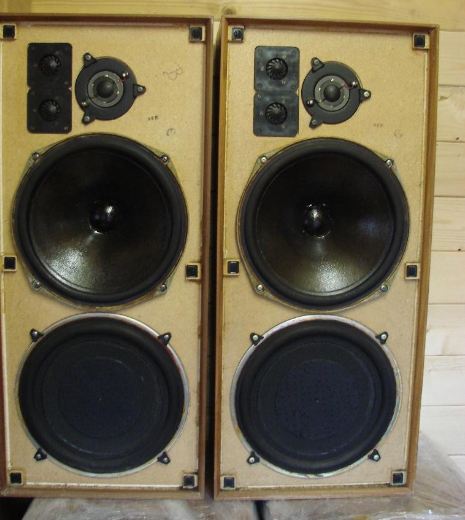
A 12" bass is hard to level match with a regular tweeter, so Celestion had the bright idea of using two for an extra 6dB.
It is, of course, 2mH series bass coil, and 4R and 16uF in series in the shunt. I just used a Celestion 25 sim to get a quick result for a 10".
I am sure the 10" B102 Legend and a horn tweeter is doable.
Speaker Detail | Eminence Speaker
Zu and the WLM Grand Viola used it.
6moons audio reviews: WLM Grand Viola Signature MkII
It looks tidy enough for 2.5kHz crossover. I think the whizzer just adds a bit of mass and damping without producing much top end. Traditionally a good bass guitar speaker which has been slightly modified lately. What's holding you back? There are some good designs at the Eminence site, including co-axials with stock crossovers, which aren't fundamentally different IMO.
A 12" bass is hard to level match with a regular tweeter, so Celestion had the bright idea of using two for an extra 6dB.
It is, of course, 2mH series bass coil, and 4R and 16uF in series in the shunt. I just used a Celestion 25 sim to get a quick result for a 10".
I am sure the 10" B102 Legend and a horn tweeter is doable.
Speaker Detail | Eminence Speaker
Zu and the WLM Grand Viola used it.
6moons audio reviews: WLM Grand Viola Signature MkII
It looks tidy enough for 2.5kHz crossover. I think the whizzer just adds a bit of mass and damping without producing much top end. Traditionally a good bass guitar speaker which has been slightly modified lately. What's holding you back? There are some good designs at the Eminence site, including co-axials with stock crossovers, which aren't fundamentally different IMO.
Last edited:
You're inspiring me!
I thought you might mean the Ditton 25, but the photo was of something completely different.
Rain is forecast for this weekend, so I may end up pulling out the speaker project and giving it another quick try. I'd start with the woofer crossover. There are a couple of spikes in the B102's response that will need to be tamed with notch filter or two. Looks to me like the one at 2.8kHz is close enough to the pass band to really matter.
What I should do is learn how to use REW with the USB mic I bought and get some quick 'n dirty frequency response measurements. That way I could use objective data to get close to a target response, instead of relying solely on my inexperienced (but old and beat up) ears.
I thought you might mean the Ditton 25, but the photo was of something completely different.
Rain is forecast for this weekend, so I may end up pulling out the speaker project and giving it another quick try. I'd start with the woofer crossover. There are a couple of spikes in the B102's response that will need to be tamed with notch filter or two. Looks to me like the one at 2.8kHz is close enough to the pass band to really matter.
What I should do is learn how to use REW with the USB mic I bought and get some quick 'n dirty frequency response measurements. That way I could use objective data to get close to a target response, instead of relying solely on my inexperienced (but old and beat up) ears.
Attachments
The photo was my current fun build. Based loosely around a WLM La Scala. Do you see the resemblance? I decided the tweeter was rubbish though, and changed it.
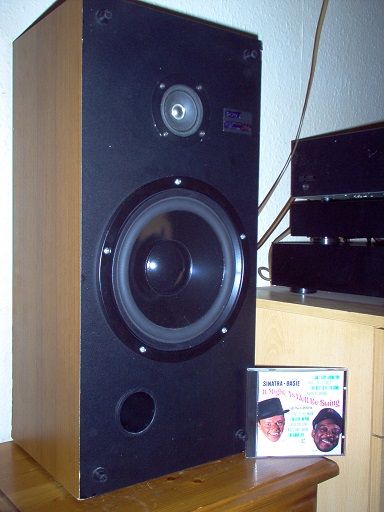
I'd just try the stock Eminence PXB2 2K5CX 2.5kHz crossover value of 2mH and 10uF and give the bass a listen. I think this crossover is considered fairly universal. That peak at 2.5kHz (the first breakup mode) is quite expected and should be already tamed by the crossover. The higher one shouldn't bother you at all. It might be a little resistance in the shunt is a good thing, time will tell.
TBH, I don't know much about horn drivers or living rooms the size of a barn. This is the UK.
I'd just try the stock Eminence PXB2 2K5CX 2.5kHz crossover value of 2mH and 10uF and give the bass a listen. I think this crossover is considered fairly universal. That peak at 2.5kHz (the first breakup mode) is quite expected and should be already tamed by the crossover. The higher one shouldn't bother you at all. It might be a little resistance in the shunt is a good thing, time will tell.
TBH, I don't know much about horn drivers or living rooms the size of a barn. This is the UK.
Attachments
Last edited:
Thanks again.
I remember from when I had it wired up that I was able to get good enough bass, and the high frequencies were fine using a tractrix horn designed by Fastlane with Selenium compression driver. It was the midrange that gave me problems, of course. It was sooo close, but there was still a bit too much energy in the 800Hz to 2kHz range for classical music. Violins sounded OK, but too shrieky. I'll try it again with this 2uH/10uF 2nd order LPF combination. I don't know what kind of HPF I'll use on the tweeters.
The reason I went with a tractrix horn is that that type should require the minimum amount of FR compensation to get close to flat. What I didn't know was that there are pretty weird lobing effects associated with tractrix horns in near-field listening conditions. You have to hold still or the tonal balance changes drastically. Not fun.
My reason for using horns was for controlled dispersion rather than for long-throw and super-high sensitivity. I can do fine with 90dB/1W/1m, although higher sensitivity doesn't hurt.
I can use my LSR305s as a target to hit. I didn't have them the last time I tried to get the big 2-ways working.
I remember from when I had it wired up that I was able to get good enough bass, and the high frequencies were fine using a tractrix horn designed by Fastlane with Selenium compression driver. It was the midrange that gave me problems, of course. It was sooo close, but there was still a bit too much energy in the 800Hz to 2kHz range for classical music. Violins sounded OK, but too shrieky. I'll try it again with this 2uH/10uF 2nd order LPF combination. I don't know what kind of HPF I'll use on the tweeters.
The reason I went with a tractrix horn is that that type should require the minimum amount of FR compensation to get close to flat. What I didn't know was that there are pretty weird lobing effects associated with tractrix horns in near-field listening conditions. You have to hold still or the tonal balance changes drastically. Not fun.
TBH, I don't know much about horn drivers or living rooms the size of a barn. This is the UK.
My reason for using horns was for controlled dispersion rather than for long-throw and super-high sensitivity. I can do fine with 90dB/1W/1m, although higher sensitivity doesn't hurt.
I can use my LSR305s as a target to hit. I didn't have them the last time I tried to get the big 2-ways working.
You've made me think. I was just trying a couple of pairs of speakers with classical music on CD. And the winner was... Monitor Audio R300-MD modified... 
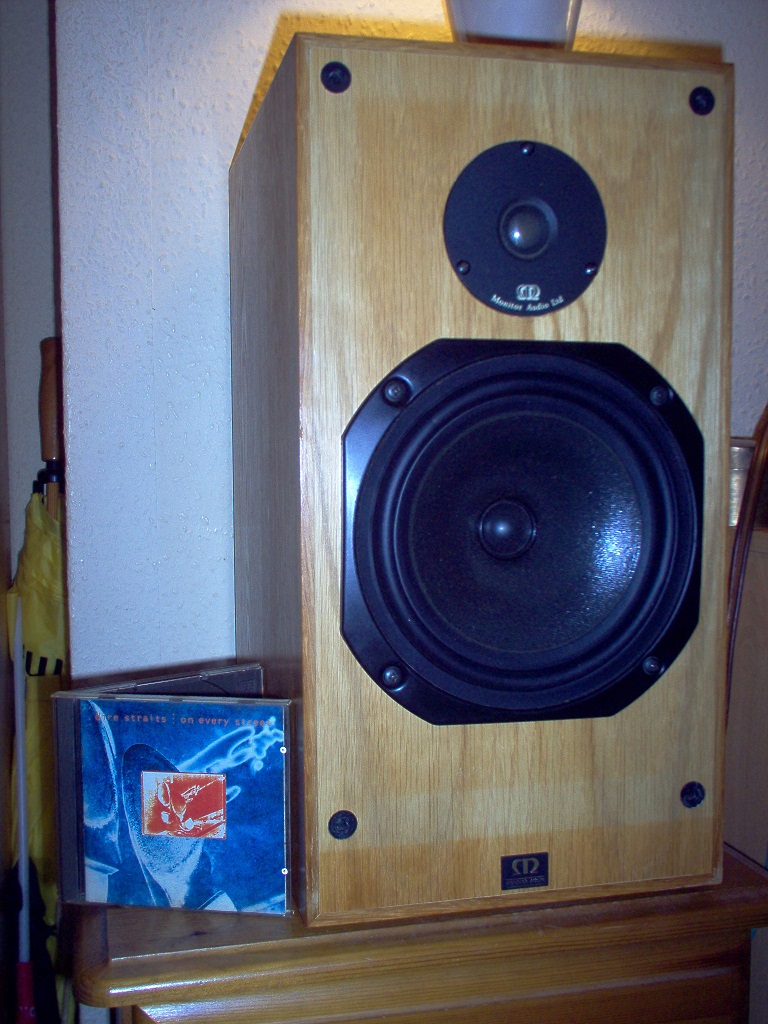
A Robin Marshall 8" Elac paper and 3/4" Seas metal dome selection, with a KEF type crossover I built that he would recognise:
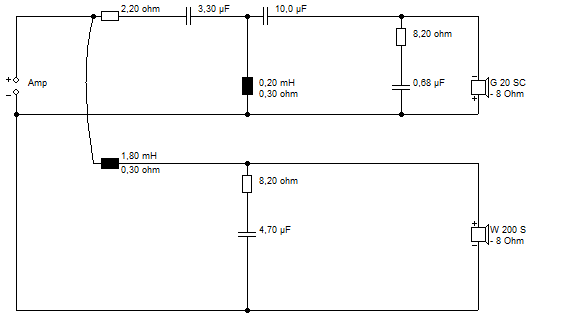
Closed box is just a natural for classical. You need low colouration, which usually means low efficiency. Low distortion and extended frequency response. All a bit Harbeth really.
I'm not sure you can do this with PA drivers. Much as I love the liveliness of high efficiency. And, TBH, anything you do in two-way is better in a three-way.
I was looking at Jeff Bagby's Fusion-8 Alchemy. It's a bit more sophisticated than Eminence crossovers, being third order bass around 2.5mH/8uF/1mH, and crossing at about 2.5kHz, well below the Beta 8A's breakup. Second order tweeter with attenuator. It must help to get well away from breakup. I suppose the only way to find out, is to build something.
A Robin Marshall 8" Elac paper and 3/4" Seas metal dome selection, with a KEF type crossover I built that he would recognise:
Closed box is just a natural for classical. You need low colouration, which usually means low efficiency. Low distortion and extended frequency response. All a bit Harbeth really.
I'm not sure you can do this with PA drivers. Much as I love the liveliness of high efficiency. And, TBH, anything you do in two-way is better in a three-way.
I was looking at Jeff Bagby's Fusion-8 Alchemy. It's a bit more sophisticated than Eminence crossovers, being third order bass around 2.5mH/8uF/1mH, and crossing at about 2.5kHz, well below the Beta 8A's breakup. Second order tweeter with attenuator. It must help to get well away from breakup. I suppose the only way to find out, is to build something.
And the lesson is: if somebody starts a thread with nothing but vague emotions about the sound problem they have, just pay no attention.*
REW (honourware or free for the ungrateful) even using a laptop mic** would have been appropriate and shown some respect for all the folks who tried to contribute. Or even pointing out some accessible recording that demonstrated the problem.
B.
*OP didn't even have the decency to feedback on the bad results from the advice provided.
**I've posted comparisons to my calibrated mic with the Mac Air mic, here's the link:
You can use your laptop mic
REW (honourware or free for the ungrateful) even using a laptop mic** would have been appropriate and shown some respect for all the folks who tried to contribute. Or even pointing out some accessible recording that demonstrated the problem.
B.
*OP didn't even have the decency to feedback on the bad results from the advice provided.
**I've posted comparisons to my calibrated mic with the Mac Air mic, here's the link:
You can use your laptop mic
Last edited:
- Home
- Loudspeakers
- Multi-Way
- Trying to mellow out Klipsch KG 4.5 tractrix horn
